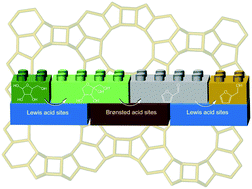Discussing the performance of beta zeolites in aqueous-phase valorization of xylose†
Abstract
The one-pot transformation of xylose into furfuryl alcohol over beta zeolites was shown to proceed via a tandem reaction. In the present work, the influence of acid site balance in the xylose conversion was systematically investigated, using BEA structured catalysts with different Si/Al ratios. Special attention was given to the catalyst acidity regarding the tolerance to water. These sites were assessed by FTIR spectroscopy of pyridine adsorbed on hydrated catalysts and compared to values for conventional dehydrated BEA zeolites. Activity results were mainly associated with total acid sites while selectivity to furfuryl alcohol could be explained by balance of water-tolerant Lewis (WT-LAS) and Brønsted (BAS) acid sites. The closer to 1 the WT-LAS/BAS ratio, the higher the selectivity to furfuryl alcohol. XRD, ICP-OES and NMR-HPDec results for spent zeolites showed that the BEA structure and chemical composition were well preserved when the catalytic test was performed at 130 °C. The activity was also seen to be very similar after two consecutive runs. However, this chemical stability was limited under mild conditions since increasing the reaction temperature to 150 °C and 170 °C led to Al leaching. Despite being susceptible to deactivation by deposition of carbonaceous material, BEA zeolites could be promptly regenerated by calcination with no impact on activity or product distribution.



 Please wait while we load your content...
Please wait while we load your content...